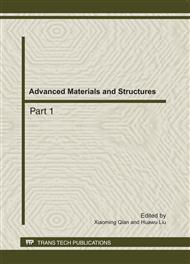[1]
Clark, A.R., "Medical Aerosol Inhalers: Past, Present, and Future," Aerosol Science and Technology, 23, 374-391 (1995).
DOI: 10.1080/02786829408959755
Google Scholar
[2]
Usmani, O.S., M.F. Biddiscombe, and P.J. Barnes, "Regional Lung Deposition and Bronchodilator Response as a Function of 2-Agonist Particle Size," Ame. J. of Respiratory and Critical Care Medicine, 172, 1497-1504 (2005).
DOI: 10.1164/rccm.200410-1414oc
Google Scholar
[3]
Taylor, K.M.G. and O.N.M. McCallion, "Ultrasonic nebulizers for pulmonary drug delivery," Int. J. of Pharmaceutics, 153, 93-104 (1997).
DOI: 10.1016/s0378-5173(97)00105-1
Google Scholar
[4]
Tsai, S.C., Y.L. Song, T.K. Tseng, Y.F. Chou, W.J. Chen, and C.S. Tsai, "High Frequency Silicon-Based Ultrasonic Nozzles Using Multiple Fourier Horns," IEEE Trans. on Ultrasonics/Ferroelectrics and Frequency Control, 51, 277-286, 2004.
DOI: 10.1109/tuffc.2004.1320783
Google Scholar
[5]
Lal, A. and R.M. White, "Micromachined Silicon Ultrasonic Atomizer," Proc. of IEEE Ultrasonics Symposium, 1, 339-342 (1996).
DOI: 10.1109/ultsym.1996.583987
Google Scholar
[6]
Lang, R., "Ultrasonic Atomization of Liquids," J. Acous. Soc. of America, 34, 6-8 (1962).
Google Scholar
[7]
Eisner, E., "Design of Sonic Amplitude Transformers for High Magnification," J. of the Acoust. Society of America, 35, 1367-1377 (1963).
DOI: 10.1121/1.1918699
Google Scholar
[8]
Tsai, S.C., Song, Y.L., Tsai C.S., Chou Y.F., and Cheng C.H., "Ultrasonic Atomization Using MHz Silicon-Based Multiple-Fourier Horn Nozzles," Appl. Phys. Lett., 88, 014102, Jan. 2, 2006 (also Virtual Journal of Nanoscale Science and Technology, January 16, 2006).
DOI: 10.1063/1.2161398
Google Scholar
[9]
Auld, B.A. Acoustic Fields and Waves in Solids, Vol. 1, Chapter 8, "Piezoelectricity", Wiley-Interscience Publication, John Wiley and Sons, NY (1973).
Google Scholar
[10]
Wortman, J.J. and R.A. Evans, "Young's Modulus, Shear Modulus, and Poisson's Ratio in Silicon and Germanium," J. of Applied Physics, 36, 153-156 (1965).
DOI: 10.1063/1.1713863
Google Scholar
[11]
Faraday, M., "On a Peculiar Class of Acoustical Figures; and on Certain Forms Assumed by Groups of Particles upon Vibrating Elastic Surfaces," Phil. Trans. Roy. Soc. London, A52, 299-340 (1831).
DOI: 10.1098/rstl.1831.0018
Google Scholar
[12]
Rayleigh, Lord, "On the crispation of fluid resting upon a vibrating support," Phil. Mag. 16(5), 50-58 (1883).
Google Scholar
[13]
Kumar, K., "Linear Theory of Faraday Instability in Viscous Liquids," Proc. Roy. Soc., London, A, 452, 1113-1126, 1996.
DOI: 10.1098/rspa.1996.0056
Google Scholar
[14]
Cheng, C.H., "MHz Ultrasonic Atomization," Ph. D. Thesis in preparation, Department of Mechanical Engineering, National Taiwan University, Taipei, Taiwan (2008).
Google Scholar
[15]
Achenbach, J.D., Wave propagation in elastic solids, North-Holland Pub. Co, New York, p.65 (1973).
Google Scholar
[16]
Shivamoggi, B.K, Perturbation methods for differential equations, Birkhauser, Boston, pp.97-99 (2003).
Google Scholar
[17]
Tsai, S.C., P. Luu, P. Childs, A. Teshome, and C.S. Tsai, "The Role of Capillary Waves in Two-Fluid Atomization," AIP Physics of Fluids, 9, 2909-2918 (1997).
DOI: 10.1063/1.869403
Google Scholar
[18]
Rayleigh, Lord, "On the Maintenance of Vibrations by Forces of Double Frequency, and on the Propagation of Waves through a Medium endowed with a Periodic Structure," Phil. Mag. 24(147), 145-159 (1887).
DOI: 10.1080/14786448708628074
Google Scholar
[19]
Yule, A.J. and AL-Suleimani, "On Droplet Formation from Capillary Waves on a Vibrating Surface," Proc. R. Soc., Lond., A, 456, 1069-1085 (2000).
DOI: 10.1098/rspa.2000.0551
Google Scholar
[20]
Barreras, F., H. Amaveda, and A. Lozano, "Transient High-Frequency Ultrasonic Water Atomization," Experiments in Fluids, 33, 405-413 (2002).
DOI: 10.1007/s00348-002-0456-1
Google Scholar
[21]
Eisenmenger, W., "Dynamic Properties of the Surface Tension of Water and Aqueous Solutions of Surface Active Agents with Standing Capillary Wves in the Frequency Range from 10 kc/s to 1.5 Mc/s," Acustica, 9, 327-340 (1959).
Google Scholar
[22]
Hirleman, E.D., V. Oechsle, and N.A. Chigier, "Response Characteristics of Laser Diffraction Particle Size Analyzers: Optical Sample Volume Extent and Lens Effects," Optical Engineering, 23, 610-619 (1984).
DOI: 10.1117/12.7973344
Google Scholar
[23]
Oeseburg, F. and F.M. Benschop, "Aerosol Generator for Sampling Efficiency Determinations under Field Conditions," J. Aerosol Science, 22, 159-180 (1991).
DOI: 10.1016/0021-8502(91)90025-d
Google Scholar
[24]
Milliken, W.J., H.A. Stone, and L.G. Leal, "The Effect of Surfactant on the Transient Motion of Newtonian Drops," AIP Physics of Fluids, A, 5, 69-79 (1993).
DOI: 10.1063/1.858790
Google Scholar


